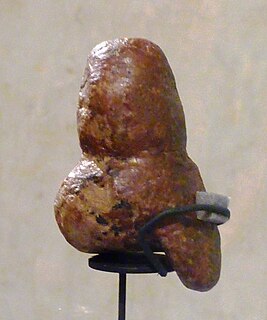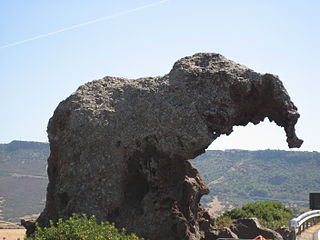
A Venus figurine is any Upper Palaeolithic statuette portraying a woman, usually carved in the round. Most have been unearthed in Europe, but others have been found as far away as Siberia, and distributed across much of Eurasia.

The Venus of Brassempouy is a fragmentary ivory figurine from the Upper Palaeolithic, apparently broken from a larger figure at some time unknown. It was discovered in a cave at Brassempouy, France in 1892. About 25,000 years old, it is one of the earliest known realistic representations of a human face.
Terramare, terramara, or terremare is a technology complex mainly of the central Po valley, in Emilia, Northern Italy, dating to the Middle and Late Bronze Age c. 1700–1150 BC. It takes its name from the "black earth" residue of settlement mounds. Terramare is from terra marna, "marl-earth", where marl is a lacustrine deposit. It may be any color but in agricultural lands it is most typically black, giving rise to the "black earth" identification of it. The population of the terramare sites is called the terramaricoli. The sites were excavated exhaustively in 1860–1910.

Costante Girardengo was an Italian professional road bicycle racer, considered by many to be one of the finest riders in the history of the sport. He was the first rider to be declared a "Campionissimo" or "champion of champions" by the Italian media and fans. At the height of his popularity in the 1920s he was said to be more popular than Mussolini and it was decreed that all express trains should stop in his home town Novi Ligure, an honour only normally awarded to heads of state.

Vietri sul Mare is a town and comune in the province of Salerno, in the Campania region of southern Italy. It is situated just west of Salerno, separated from the Port of Salerno by only a harbour wall. The town is known for its polychrome ceramics, a tradition since at least the 15th century, and is considered to be the gateway to the Amalfi Coast.

Luigi Pigorini was an Italian palaeoethnologist, archaeologist and ethnographer.

Federico Halbherr was an Italian archaeologist and epigrapher, known for his excavations of Crete. A contemporary, good friend, and trusted advisor of Arthur Evans, he began excavating at Phaistos before Evans began excavating at Knossos. Some of his explorations were funded by the Archaeological Institute of America.
Michele Mari is an Italian novelist, short story writer, academic critic and poet. The son of a Milanese industrial designer and artist, Enzo Mari, Mari teaches Italian literature at the Università Statale di Milano; he is considered one of the leading experts of 18th century Italian literature.

The Giants of Mont'e Prama are ancient stone sculptures created by the Nuragic civilization of Sardinia, Italy. Fragmented into numerous pieces, they were discovered in March 1974 on farmland near Mont'e Prama, in the comune of Cabras, province of Oristano, in central-western Sardinia. The statues are carved in local sandstone and their height varies between 2 and 2.5 meters.

The Epigravettian was one of the last archaeological industries and cultures of the European Upper Paleolithic. It emerged after the Last Glacial Maximum around ~21,000 cal. BP and is considered to be a cultural derivative of the Gravettian culture. Initially named Tardigravettian in 1964 by Georges Laplace in reference to several lithic industries, found in Italy it was later renamed in order to better emphasize its independent character.

The Nuragic bronze statuettes are typical Nuragic Sardinian bronze sculptures of the final phase of the Bronze Age and the early Iron Age.
Paolo Isotta was an Italian musicologist and writer.

The Venus of Mauern is a Venus figurine from the paleolithic era. The statuette stems from the Gravettian and is about 27.000 years of age. The figurine consists of red painted limestone and was found in 1948 in Mauern (Rennertshofen). It is housed in the Archäologische Staatssammlung in Munich.

The Venus figurines of Balzi Rossi from the caves near Grimaldi di Ventimiglia (Italy) are thirteen Paleolithic sculptures of the female body. Additionally, two small depictions of the human head were discovered at the same place. The age of these figurines cannot be determined because of missing archaeological context data. It is usually accepted that these figurines stem from the Gravettian, about 24,000 to 19,000 years old. Most of the sculptures consist of steatite and are between 2.4 and 7.5 cm in height. Between 1883 to 1895 the figurines were discovered by the antique dealer Louis Alexandre Jullien at the cave complex Balzi Rossi at the Ligurian coast. Eight of these sculptures are housed in the museum Saint-Germain-en-Laye near Paris.

The Urfa man, also known as the Balıklıgöl statue, is an ancient human shaped statue found in excavations in Balıklıgöl near Urfa, in the geographical area of Upper Mesopotamia, in the southeast of modern Turkey. It is dated circa 9000 BC to the period of the Pre-Pottery Neolithic, and is considered as "the oldest naturalistic life-sized sculpture of a human". It is considered as contemporaneous with the sites of Göbekli Tepe and Nevalı Çori.
Antonio Gianettini was an Italian organist, concertmaster and composer.

The Elephant's Rock is a large boulder of trachyte and andesite, eroded by the atmospheric agents that gave it the shape of an elephant. It is about 4 meters high.
Marco Lastri was an eclectic and polymath writer, active in Florence, region of Tuscany, Italy.














